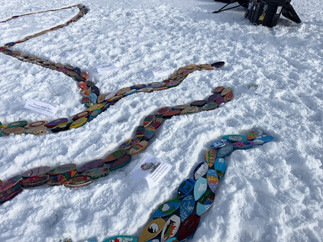Utqiagvik April 2024 - 8th Grade Field Trip and Float Your Boat Deployment
- arcticfloatboat
- Apr 29, 2024
- 3 min read
Updated: Apr 30, 2024

A team of scientists recently flew north to Utqiagvik, Alaska to deploy buoys, help with 8th grade sea ice field trip at Hopson Middle School (the most northern Middle School in the USA), and also deploy Float Your Boat wooden boats from 20 schools in the lower 48 states. The team deploying the wooden boats included folks from US Interagency/International Arctic Buoy Program (USIABP/IABP) and PolarSTEAM Educator Fellow, Keegan Heron.
The annual 8th grade sea field trip hosted by UIC takes the students to the beach and out on the sea ice to do a series of learning stations with local experts and visiting scientists. Rather than visiting a town park or open space for a field trip like students do in warmer land-locked locations, the students went out on the frozen ocean sea ice. The field experience was followed by a day in the classroom learning about Indigenous Knowledge of sea ice; weather, snow and ice physics, biology, remote sensing using kites and drones, and decorating Float Your Boat wooden boats.
A few days later the IABP team deployed 400 boats on landfast sea ice 3 miles north of Utqiagvik, Alaska on April 4, 2024 (Figs. 1 - 2). While out on the ice the team also tested a new ROV (Fig. 3) that will be used to take pictures and video of the underside of sea ice to produce 3 dimensional models that will be used for art (e.g. cykeener.com) and science.
Landfast sea ice or shorfast ice is ice that is fastened to land or the ocean floor and doesn’t usually move once it has set in the winter until the spring melt. Strong winds, high tides and ocean currents can break the ice so it moves before the spring melt, especially over the deeper areas of the coast. Break up of all the landfast sea ice normally occurs in mid-June just before summer in Utqiagvik.
Float Your Boat wooden boats deployed were decorated by students from::
Hopson Middle School, Utqiagvik, Alaska
Shiloh CUSD 1, Hume, Illinois
Eleanor Roosevelt High School - Prince George's County Public Schools, Maryland
Spruce Elementary, Lynwood, Washington
Jordan-Matthews High School, Siler City, North Carolina
Desert Ridge Middle School, Albuquerque, New Mexico
Academy of Environmental Sciences, Jacksonville, Florida
Ashford School, Ashford, Connecticut
South Vermillion High School, Clinton, Indiana
Hillbrook School, Los Gatos, California
Cedar Falls Community Schools, Cedar Fall, Iowa
Faribault High School, Faribault, Minnesota
Durham Public Schools, Durham, North Carolina
USIABP/IABP Team:
Ignatius Rigor, Research Scientist, Polar Science Center (PSC), Applied Physics Laboratory (APL), University of Washington (UW);
Cy Keener, Professor of Art (Sculpture and Emerging Technology), University of Maryland;
Jim Johnson, Research Engineer, PSC/APL/UW;
Ben Cohen, Research Scientist at PSC/APL/UW, and grad. Student in Earth and Space Science, UW; and
Cassandra Lam, Electrical Engineering Student, UW.
Keegan Heron, Educator at Durham High School, and PolarSTEAM Educator Fellow.
Olik “Justin” Brower, Indigenous Sea Ice Expert, UIC Science


Figure 3. The wooden boats were deployed with an Ice Ball and an Ice Tracker buoy during testing of a new ROV that will be used to take pictures and videos of the underside of sea ice.
Figure 4. Keegan, Cassandra and Ignatius “drawing” the whale tail.
Figure 5. Done!
Figure 6. Keegan with the wooden boats from Durham High School!
Figure 7. Close up of the wooden boats from each school on the sea ice.
Figure 8. Watch closely to view each of the schools' mascot signs and students' boats.

Figure 9. Picture from drone taken a day later. The wind was blowing and covered up the boats with a slight layer of snow. Flight path of drone shown as cyan dashed line on Fig. 2.
Acknowledgements: Support for the USIABP/IABP and PolarSTEAM team for this effort was provided by the National Science Foundation, and other contributors to the USIABP including the Office of Naval Research, NOAA, NASA.

















































Comments